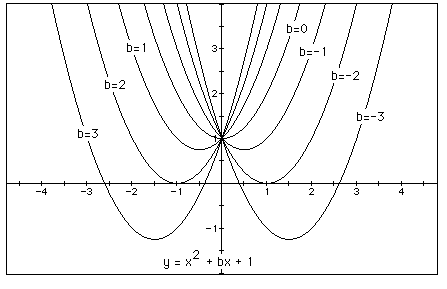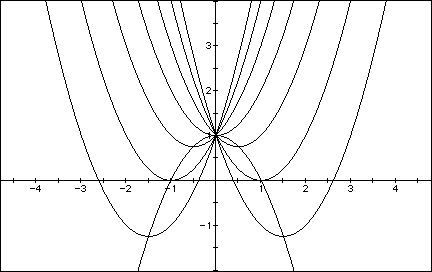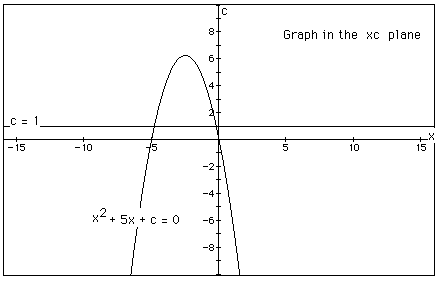The Department of Mathematics Education
J. Wilson, EMAT 6680
It has now become a rather standard exercise, with available
technology, to construct graphs to consider the equation
![]()
and to overlay several graphs of
![]()
for different values of a, b, or c as the other two are held
constant. From these graphs discussion of the patterns for the
roots of
![]()
can be followed. For example, if we set
![]()
for b = -3, -2, -1, 0, 1, 2, 3, and overlay the graphs, the
following picture is obtained.

We can discuss the "movement" of a parabola as b
is changed. The parabola always passes through the same point
on the y-axis ( the point (0,1) with this equation). For b <
-2 the parabola will intersect the x-axis in two points with positive
x values (i.e. the original equation will have two real roots,
both positive). For b = -2, the parabola is tangent to the x-axis
and so the original equation has one real and positive root at
the point of tangency. For -2 < b < 2, the parabola does
not intersect the x-axis -- the original equation has no real
roots. Similarly for b = 2 the parabola is tangent to the x-axis
(one real negative root) and for b > 2, the parabola intersects
the x-axis twice to show two negative real roots for each b.
Now consider the locus of the vertices of the set of parabolas
graphed from
![]() .
.
Show that the locus is the parabola
![]()
Click Here
for generalization to the locus of vertices of a parabola.

Consider again the equation
![]()
Now graph this relation in the xb plane. We get the following
graph.

If we take any particular value of b, say b = 3, and overlay
this equation on the graph we add a line parallel to the x-axis.
If it intersects the curve in the xb plane the intersection points
correspond to the roots of the original equation for that value
of b. We have the following graph.

For each value of b we select, we get a horizontal line. It
is clear on a single graph that we get two negative real roots
of the original equation when b > 2, one negative real root
when b = 2, no real roots for -2 < b < 2, One positive real
root when b = -2, and two positive real roots when b < -2.
Consider the case when c = - 1 rather than + 1.

We can see for c=-1 any value of b will give us a root to our original quadratic equation. We can also see that one root will be positive, while the other is negative.
Now consider different values for c. The following equations were graphed:

to give the following graph:

As we can see the line 2x+b=0 goes through the vertices for
c > 0. Notice for b,c > 0 there are no real roots for b
below this vertex. For b < 0 ,c > 0 there would be no real
roots above this value. This occurs when ![]() .
.
Recall our original equation:![]() when
when![]() we get
we get ![]() .
.
Therefore for c > 0 we will have two real roots for ![]() . We also can see from the graph that for
a negative c we will always have two real roots for any value
of b. For negative values of c
. We also can see from the graph that for
a negative c we will always have two real roots for any value
of b. For negative values of c ![]() would
be satisfied for any value of b.
would
be satisfied for any value of b.
This gives us a graphical interpretation of the discriminant of the quadratic formula when a=1.
In the following example the equation
![]()
is considered. If the equation is graphed in the xc plane,
it is easy to see that the curve will be a parabola. For each
value of c considered, its graph will be a line crossing the parabola
in 0, 1, or 2 points -- the intersections being at the roots of
the original equation at that value of c. In the graph, the graph
of c = 1 is shown. The equation
![]()
will have two negative roots -- approximately -0.2 and -4.8.

There is one value of c where the equation will have only 1 real root -- at c = 6.25. For c > 6.25 the equation will have no real roots and for c < 6.25 the equation will have two roots, both negative for 0 < c < 6.25, one negative and one 0 when c = 0 and one negative and one positive when c < 0.
What significance does c=6.25 have? How is it related to b?
In this equation b=5. Notice or
or
 .
.
Let us consider several graphs in the x-c plane:

The locus of vertices is the yellow line and has the equation
![]() .
.
By graphing the equation ![]() in the x-b
and x-c planes we were able to determine a relationship
between the values of b and c that would give us a real solution.
It is gives us a graphical interpretation of the discriminant
in the x-b
and x-c planes we were able to determine a relationship
between the values of b and c that would give us a real solution.
It is gives us a graphical interpretation of the discriminant
![]() (for a=1).
(for a=1).
How would changing a affect our graphs in the x-b and x-c planes?
Return to Cathryn Brooks: Return
Send e-mail to jwilson@coe.uga.edu